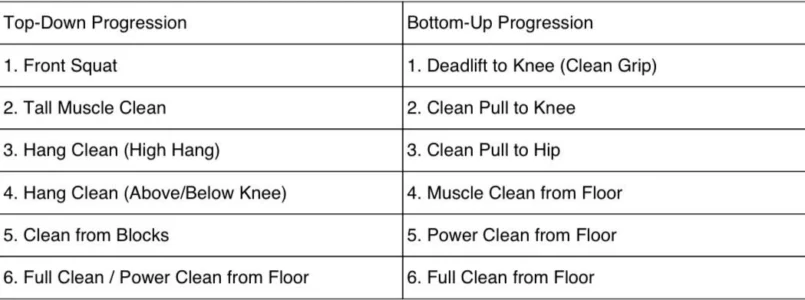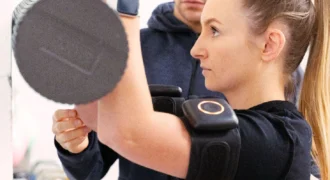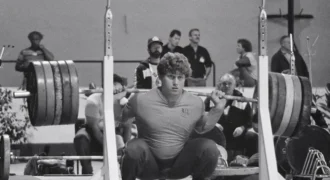Introduction
Recently, I tweeted about some work I did with my group of sprinters in China, and how it led to new personal bests. At the heart of it all, and really at the core of our job as strength and conditioning coaches, is figuring out how to keep athletes progressing. It’s always about finding the right next step that pushes them toward the adaptation we’re aiming for. That’s usually the starting point when I sit down to write a program, and I’d say that’s true for most coaches too.
I decided to put my recent thoughts on building progressions in Olympic lifts and their derivatives down on paper. In this case, I’m mostly talking about catching and pulling derivatives (read more about them here). The whole other debate is whether olympic lifts are a must (as a very flexible and pragmatic coach myself, I don’t really see it as mandatory), but I won’t get into that.
The benefits of Olympic lifts are well-documented in the literature [1]. They’ve been shown to improve power output [1,2], support RFD development [3], and enhance vertical jump performance [4,5].
Olympic lift variations can also help develop a wide range of physical qualities along the strength- power spectrum [G]. One study found that weightlifting training is an effective method for improving strength, countermovement jump (CMJ), squat jump (SJ), and sprint speed [G].
A number of strength qualities underpin performance in the weightlifting derivatives. These qualities include high RFD, the ability to use the stretch-shortening cycle, high maximal strength, high- velocity strength, and high segmental coordination [7].
While the primary goal of these lifts is to improve triple extension and power, there are other important benefits too, like developing the ability to transition quickly from eccentric to concentric, exposing athletes to the high eccentric forces during the catch phase, and building the specific coordination required to execute the lifts successfully. They also offer the opportunity to introduce a wide variety of challenging movement patterns [8].
And that’s where I want to stay for a bit today. Most of these benefits can also be achieved through loaded jumps (though I see them as distinct from Olympic lifts given the different RFD demands), and just to be clear again, I don’t think Olympic lifts are a must. I completely understand coaches who choose to skip them in their programs. But what gives Olympic lifts an edge is variety. That alone becomes a form of progression and a way to load athletes differently. There are many ways to go about it, and most of them will probably work, as long as they make sense for your athletes and context.
What you choose will depend on the athletes you’re working with and their level of experience. Some progressions are better suited for those with solid technique and years of exposure to Olympic lifts. But within a well-structured LTAD program, there’s enough room to work through all of these variations. That’s where the first layer of progression starts: based on technique (top-down, bottom-up, or mixed-approach variations)
What gives Olympic lifts an edge is variety. That alone becomes a form of progression and a way to load athletes differently, says @MatijaPavlovic
Share on X
Based on the Technique
This is usually the first step, where you start when teaching someone how to perform Olympic lifts. There are a few schools of thought on how to go about it. Most assume the athlete already has solid technique in movements like the deadlift and front squat. You can take a top-down approach, a bottom-up approach, or something in between. Personally, I don’t stick to one method. I adjust based on what I see in front of me. Might be worth a future post just to break down the different teaching methods and how to apply them.

Image: Table of top-down and bottom-up progressions for teaching the Olympic lifts
Here are example progressions for the bottom-up and top-down teaching approaches. There are plenty of variations, but this gives you the general idea behind each (This example was generated by ChatGPT, and it makes solid sense)
Based on Force Velocity Profile
Mostly based on the great work of Suchomel and Comfort [7] and by taking into account all the shortcomings of the FV profiling and keeping in mind that it only covers the concentric (less potent) side of the curve and of the FV relationship, it definitely makes sense to start with something high-force/ low-velocity and gradually navigate towards high-velocity/low-force.
However, another aspect that must be considered is the selection of exercises to meet the training goals of each resistance training phase. The characteristics of each weightlifting derivative may lead practitioners to prescribe certain derivatives in specific training phases. Specifically, the biomechanical and physiological characteristics of each weightlifting derivative may indicate that certain derivatives should be prescribed during certain training phases to meet the training goals of each phase and achieve optimal adaptations of strength, RFD, and power while training through specific joint angles that are characteristic to different phases [7].
The characteristics of each weightlifting derivative may lead practitioners to prescribe certain derivatives in specific training phases, says @MatijaPavlovic
Share on X
Example:
Mid-Thigh Pull → Power Clean from Floor → Hang Power Clean → Hang High Pull
Video: Examples of the mid-thigh pull, power clean, hang power clean, and hang high pull
Based on the Work Done
This one is really interesting and not something I see many coaches using but I like it a lot. Especially because it blends easily with other types of progressions, particularly the ones discussed later in this post.
Work = Force × Displacement
Or more specifically: mass × g × vertical displacement
What makes this method useful is how well it aligns with tapering. You’re essentially reducing the total work done as you approach competition, which also reduces overall training stress (sounds a lot like the textbook definition of a taper, doesn’t it?)
The key variable here is displacement. While you can reduce the force side of the equation, it’s rarely the go-to strategy. Instead, we usually lower total work by:
- Reducing volume (fewer sets and reps)
- Reducing intensity/load
- Removing the catching portion (focusing only on the concentric part)
- Decreasing range of motion (which directly lowers displacement and, therefore, total work) Here’s an example of that kind of progression—starting with the full lift and then gradually decreasing ROM and removing the catch:
Power Clean → Hang Power Clean → Hang High Pull
Based on the SSC
This and the next progression are closely related, almost overlapping and could easily fall under the same umbrella. Still, I like to look at them separately, mainly because they might come into play at different stages of LTAD. This one is more relevant for younger athletes or beginners in the early phases of learning.
In an SSC-based progression, we gradually introduce rapid eccentric-to-concentric transition into the lift. There are a few reasons why this makes sense:
- From a technical and coordinative standpoint: fewer moving parts = less complexity = easier to learn
- Beginners usually lack eccentric strength at high velocities
- Less DOMS early on, which helps with training frequency and learning
A typical progression might start with a concentric-only movement (Non-Counter-Movement). For example, when teaching the hang power clean, you could start from the mid-thigh without any dip, then gradually add a lowering phase to the hang position. Over time, you increase the speed of the eccentric portion and speed up the reversal into the concentric action.
Mid Thigh Pull → Pull From The Knee → Hang High Pull → Hang Power Clean
Video: Example of using the olympic lifts to target the stretch shortening cycle using the mid thigh pull, pull from the knee, hang high pull, and hang power clean
Based on the Eccentric Demands
Eccentric demands in Olympic lifts and their derivatives mainly come from two sources: the catch phase (receiving the barbell) and the initiation of the lift. While removing the catch was previously mentioned as a way to reduce overall work, in this case, the focus shifts toward managing eccentric stress and technical complexity.
The catch adds a significant eccentric load, especially when receiving the bar in a deep position. Removing it (via pulling derivatives) can reduce stress and simplify execution. This makes pulls useful in several scenarios: approaching competition, deload weeks, concentric-focused blocks, or within microcycles in team sports. Additionally, pulling derivatives allow for overload, as athletes can use loads exceeding their 1RM for the full lift [7]. (Though skill and supramaximal loading aren’t the focus here.)
If the catch is desired, we can go with a full lift, allowing the athlete to decelerate the barbell over a longer distance; this requires more technical proficiency, mobility, and control. Alternatively, catching in the power position demands higher eccentric RFD and rapid deceleration, exposing the athlete to faster eccentric loading.
The initiation of the lift also plays a role in eccentric stress. While this was mentioned earlier under the SSC progression, I like to separate the two: this approach applies mainly to already proficient lifters. It’s relevant in derivatives that don’t start from the floor.
When we want to minimize eccentric loading, especially on the hamstrings, non-Counter-Movement options like Mid-Thigh Pull, Mid-Thigh Power Clean, High Pull, or Pull from the Knee are viable.
When we want to add eccentric loading, we can progress toward CM initiations, starting with a slow lowering phase (useful in RTP scenarios), then moving toward a fast, explosive eccentric dip.
Example of starting with non-CM initiation and without catching; progression towards initiation with CM; and adding the catch in the power position:
Mid Thigh Pull → High Pull From the Knee → Hang High Pull → Hang Power Clean
Video: Example of the mid thigh pull, high pull from the knee, hang high pull, and hang power clean
Based on Acceleration – Time to Peak Velocity
The ultimate progression I use with my most advanced athletes is built around a few key principles I’ve picked up from Rolf Öhman, Randy Huntington, Robert Šimonič, and other coaches far smarter than me.
This approach is built on several key principles that shape how we progress the lifts. Acceleration is king. It’s the main performance marker we’re trying to develop. From that idea comes the goal of turning a “U” into a “V” meaning we want a sharp, rapid transition from eccentric to concentric.
The combination of high eccentric velocity and rapid rate of force development leads to an explosive concentric phase. To get there, we follow a progression: from slow to fast, from large (full range) to short (partial, sharper ranges), and ultimately toward matching the time to peak velocity (TpV) of the athlete’s actual sport or event.
Video: Examples of a power clean from the floor and block power cleans from various heights
We increase eccentric V to trigger rapid elastic energy use in a short time and we manipulate ROM in order to achieve TPV that is specific to our discipline.
Full ROM = more TUT, higher peak Velocity
Partial ROM = shorter TpV, higher acceleration
Power Clean
Used same logic—shortened ROM to lower TpV.
- Started with full ROM
- Added boxes to reduce pull distance
Example:
Power Clean from the Floor → 6inch Block Power Clean → 12inch Block Power Clean

Image: Chart depicting the map of how you can program the olympic lifts based on what your goals are for the movement
Conclusion
No matter if you have used, are currently using, or are planning to use Olympic weightlifting exercises and their derivatives, they remain a versatile and valuable tool in your coaching toolbox, capable of playing a role across a wide range of environments and populations you might work with.
If you decide to include them in a program, the next question becomes whether to prioritize catching or pulling derivatives. Whichever path you choose, whether you prefer to dump the catch and rely on derivatives or emphasize the many benefits of catching ,the key will always be a proper, well-thought-out progression. I hope this article helps you better frame your approach to building those progressions.
For demonstrations of the lifts mentioned in this article, check out the University of Salford playlist
References
- Hori, N., Newton, R. U., Nosaka, K., & Stone, M. H. (2005). Weightlifting exercises enhance athletic performance that requires high-load speed strength. Strength and Conditioning Journal, 27(4), 50–55
- Hedrick, A., & Wada, H. (2008). Weightlifting movements: Do the benefits outweigh the risks? Strength and Conditioning Journal, 30(G), 2G–35.
- MacKenzie, S. J., Lavers, R. J., & Wallace, B. B. (2014). A biomechanical comparison of the vertical jump, power clean, and jump squat. Journal of Sports Sciences, 32(1G), 157G–1585. https://doi.org/10.1080/02G40414.2014.U08320
- Hackett, D., Davies, T., Soomro, N., & Halaki, M. (201G). Olympic weightlifting training improves vertical jump height in sportspeople: A systematic review with meta- analysis. British Journal of Sports Medicine, 50(14), 8G5–872.
- Berton, R., Lixandrão, M. E., Pinto e Silva, C. M., & Tricoli, V. (2018). Effects of weightlifting exercise, traditional resistance and plyometric training on countermovement jump performance: A meta-analysis. Journal of Sports Sciences. Advance online publication. https://doi.org/10.1080/02G40414.2018.143474G
- 6. G. Morris, S. J., Oliver, J. L., Pedley, J. S., Haff, G. G., & Lloyd, R. S. (2022). Comparison of weightlifting, traditional resistance training and plyometrics on strength, power and speed: A systematic review with meta-analysis. Sports Medicine. Advance online publication. https://doi.org/10.1007/s4027U-021-01G27-2
- Suchomel, T. J., Comfort, P., & Stone, M. H. (2015). Weightlifting pulling derivatives: Rationale for implementation and application. Sports Medicine, 45(G), 823–83U. https://doi.org/10.1007/s4027U-015-0314-y
- Suchomel, T. J., Comfort, P., & Lake, J. P. (2017). Enhancing the force–velocity profile of athletes using weightlifting derivatives. Strength and Conditioning Journal, 39(1), 10–20. https://doi.org/10.151U/SSC.0000000000000275
The post A Structured Approach to Progressing Olympic Weightlifting and Its Derivatives appeared first on SimpliFaster.







